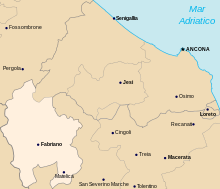Roman Catholic Diocese of Jesi
|
Diocese of Iesi Dioecesis Aesinus |
|
|---|---|

Cathedral in Iesi
|
|
| Location | |
| Country | |
| Ecclesiastical province | Ancona-Osimo |
| Statistics | |
| Area | 315 km2 (122 sq mi) |
| Population - Total - Catholics |
(as of 2006) 76,000 73,650 (96.9%) |
| Parishes | 41 |
| Information | |
| Denomination | Catholic Church |
| Rite | Roman Rite |
| Established | 6th Century |
| Cathedral | Basilica Cattedrale di S. Settimio |
| Current leadership | |
| Pope | Francis |
| Bishop | Gerardo Rocconi |
| Map | |
 |
|
| Website | |
| www2.chiesacattolica.it | |
The diocese of Iesi (Latin: Dioecesis Aesinus) is a Catholic ecclesiastical territory in the Marche, Italy. It is a suffragan of the archdiocese of Ancona-Osimo.
Saint Septimius, martyred in 307, is venerated as the first bishop of Jesi. Saint Florianus, who was cast into the Esino in the Diocletian persecution, is also venerated (perhaps he is confounded with Saint Florianus who was cast into the Enus or Anisus). Other bishops of antiquity were Martianus (c. 500), Calumniosus (c. 647), Honestus. The relics of these three were discovered in 1623.
In 1245 Pope Innocent IV deposed the intruder Armannus and placed in his stead the Franciscan Gualtiero, an Englishman and a friend of John of Parma, general of the order and patron of the Franciscan Spirituals, spoken of by Salimbene as "bonus cantor, bonus praedicator, bonus dictator". Bishop Severinus in 1237 laid the foundations of the new cathedral, a magnificent structure; the old one, now San Nicola, was outside the city, and in the eighteenth century had fallen into ruin.
Gabriele del Monte (1554) introduced the reforms of the Council of Trent, which he had attended. His successors were Cardinal Camillo Borghese (1597), afterwards Pope Paul V; Cardinals Tiberio Cenci (1621) and Alderano Cybo (1656), noted for their benefactions; Antonio Fonseca (1724), who restored the cathedral and founded a hospital. Cardinal Caprara, afterwards Archbishop of Milan, who concluded the Concordat with Napoleon, was Bishop of Jesi (1800–02). He was succeeded by Antonio M. Odescalchi, deported to Milan by the French in 1809.
...
Wikipedia
